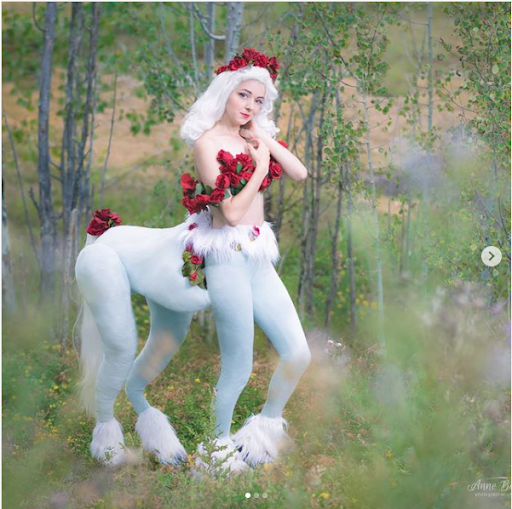Image Attribution: “Cosplay With Limits” by Carlein Kay is licensed under CC0. (See interactive map)
Within society, women have struggled to have their voices and ideas respected for centuries. Placing value purely on a woman’s sexual appearance – the current dominant ideology of today – is seen heavily across all fan cultures, especially cosplay. Basing their appearances on existing media, female cosplayers have few characters to choose from that are not already heavily sexualized in one way or another. This cosplay by Ginny Di depicts one of the centaurs from Disney’s Fantasia, with all pieces being made by the cosplayer herself. Despite the extreme talent and hard work required to create a costume of this level, with back legs that walk with the wearer, she constantly receives comments and criticism on her work. These critiques mostly include comments about how she did something deemed ‘wrong’ with the making of her costumes, “My first version’s back legs were under-stuffed (something that the internet took great pride in pointing out to me, over and over!). . .” (Di). While this may seem like comments anyone would receive, female cosplayers are more likely to be looked down upon and condemned simply because of their gender. As Natasha L. Hill said, “The exclusion of women as members of fan communities and objectification of their presence is an example of how subculture is deviant but upholds some hegemonic practices about gender dynamics. . .” (Hill, p.64), a statement that can be seen at play in almost any comment section of a female cosplayers work. The only time that female cosplayers seem to get a pass is when they are conventionally attractive and sexy, which validates them in the eyes of the dominant society. Because if you are going to deviate from the norm, you at least should look good while doing it.
Ginny Di’s piece is a fabulous feat of engineering and craftsmanship alike. Not only do the legs walk with the body mimicking a horse’s gait, but the detail of the visual aspects like the hair or decorations is impeccable. While this is a piece that is seen as sexual based on its appearance by society, it is a piece that is heavily gendered. With extremely feminine qualities – the demure nature, the long hair, the flowers – the cosplayer is able to accentuate these aspects with her own body as a woman. These types of cosplays are extremely common in the cosplay community, women mostly dressing as certain characters and only in a sexualized way; accentuating the curves of the body with skin tight suits, or revealing cutaways, female cosplayers feel they must conform to this stereotype of characters in order to be accepted. In a community about finding yourself surrounded by others that larger society has deemed ‘unwanted’ why is there still pressure to conform and fit in with unrealistic standards?
Works Cited
Di, G. (n.d.). About. Ginny Di. Retrieved from https://www.ginnydi.com/about.
Hill, N. L. (n.d.). Embodying cosplay: Fandom communities in the USA. ScholarWorks @ Georgia State University. Retrieved from https://scholarworks.gsu.edu/anthro_theses/119/.
